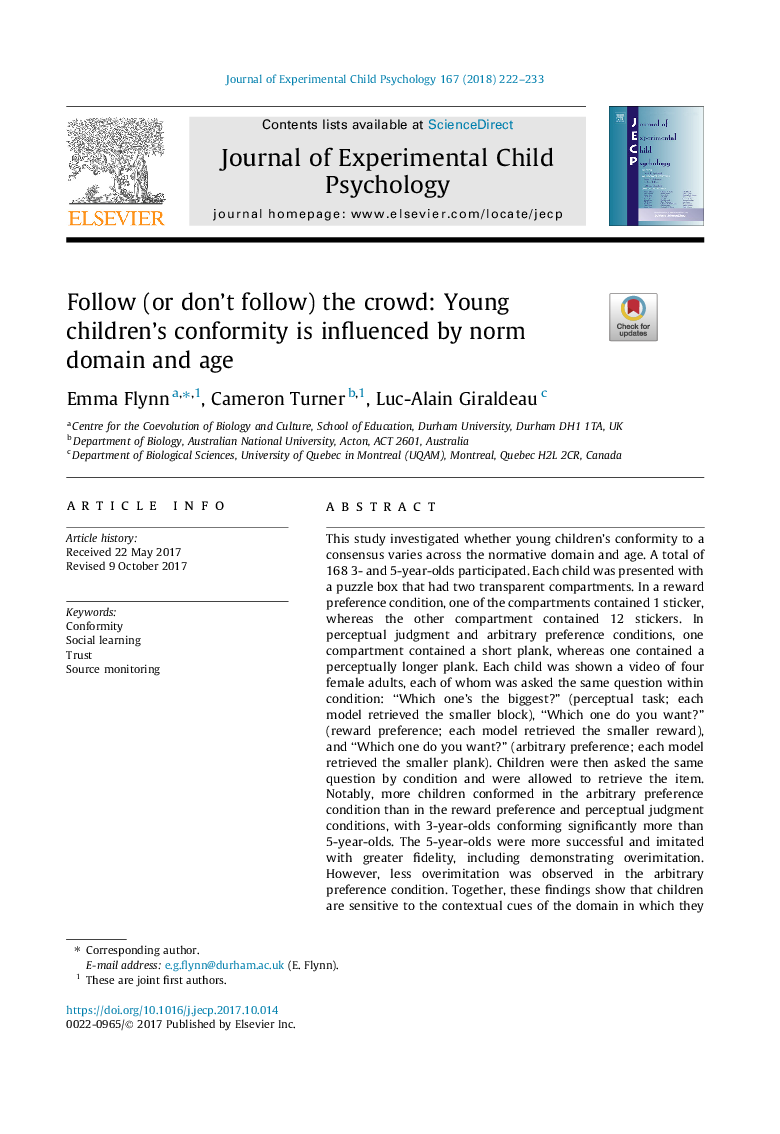| کد مقاله | کد نشریه | سال انتشار | مقاله انگلیسی | نسخه تمام متن |
|---|---|---|---|---|
| 7274126 | 1473445 | 2018 | 12 صفحه PDF | دانلود رایگان |
عنوان انگلیسی مقاله ISI
Follow (or don't follow) the crowd: Young children's conformity is influenced by norm domain and age
ترجمه فارسی عنوان
پیروی از جمعیت (یا پیروی نکنید): انطباق کودکان با دامنه و سن دامنه تحت تاثیر قرار می گیرد
دانلود مقاله + سفارش ترجمه
دانلود مقاله ISI انگلیسی
رایگان برای ایرانیان
کلمات کلیدی
مطابقت، یادگیری اجتماعی، اعتماد، نظارت بر منبع،
ترجمه چکیده
این مطالعه به بررسی اینکه آیا برابری اطفال با هماهنگی در دامنه و سن قانونی متفاوت است یا خیر. در مجموع 168 3 و 5 ساله شرکت کردند. هر کودک با یک جعبه پازل که دارای دو بخش شفاف بود ارائه شد. در یک شرایط ترجیح پاداش، یکی از محفظه ها حاوی 1 برچسب بود، در حالی که بخش دیگری شامل 12 برچسب بود. در قضاوت ادراکی و شرایط ترجیع دلخواه، یک بخش حاوی یک تخته کوتاه بود، در حالی که در یک پانل ادراکی طولانی تر بود. هر کودک تصویری از چهار زن بالغ نشان داد که هر کدام از آنها یک سوال مشابه را در شرایط پرسیدند: کدام یک بزرگترین است؟ (وظیفه ادراکی؛ هر مدل بلوک کوچکتر را بازیابی کرد)؛ کدام یک را می خواهید؟ (پاداش اولویت؛ هر مدل پاداش کوچکتر را بازیابی کرد)، و کدام یک را می خواهید؟ (اولویت دلخواه؛ هر مدل بازده کوچکتر). پس از آن بچه ها از همان سؤال مطابق شرایط پرسیدند و مجاز به بازبینی آیتم شدند. قابل ذکر است که بیشتر کودکان در شرایط ترجیحی خودسرانه نسبت به مقررات پاداش و قضاوت ادراکی، با 3 ساله که به طور قابل توجهی بیش از 5 ساله هستند، مطابقت دارند. 5 ساله موفق تر بودند و با وفاداری بیشتر تقلید می کردند، از جمله عدم تجدید نظر. با این حال، در موارد ترجیع دلخواه، بیش از حد مجاز مشاهده شد. با هم، این یافته ها نشان می دهد که کودکان به نکات متنی دامنه حساس هستند که در آنها شاهد هنجارها هستند و بر اساس چنین نشانه های متناسب با خودشان متفاوت است. علاوه بر این، کودکان می توانند اطلاعاتی را که برای به دست آوردن اهداف خود به کار می روند، حرکت دهند.
موضوعات مرتبط
علوم انسانی و اجتماعی
روانشناسی
روانشناسی رشد و آموزشی
چکیده انگلیسی
This study investigated whether young children's conformity to a consensus varies across the normative domain and age. A total of 168 3- and 5-year-olds participated. Each child was presented with a puzzle box that had two transparent compartments. In a reward preference condition, one of the compartments contained 1 sticker, whereas the other compartment contained 12 stickers. In perceptual judgment and arbitrary preference conditions, one compartment contained a short plank, whereas one contained a perceptually longer plank. Each child was shown a video of four female adults, each of whom was asked the same question within condition: “Which one's the biggest?” (perceptual task; each model retrieved the smaller block), “Which one do you want?” (reward preference; each model retrieved the smaller reward), and “Which one do you want?” (arbitrary preference; each model retrieved the smaller plank). Children were then asked the same question by condition and were allowed to retrieve the item. Notably, more children conformed in the arbitrary preference condition than in the reward preference and perceptual judgment conditions, with 3-year-olds conforming significantly more than 5-year-olds. The 5-year-olds were more successful and imitated with greater fidelity, including demonstrating overimitation. However, less overimitation was observed in the arbitrary preference condition. Together, these findings show that children are sensitive to the contextual cues of the domain in which they are witnessing norms and vary their own conformity based on such cues. Furthermore, children can navigate which information to copy to fulfil their own ends.
ناشر
Database: Elsevier - ScienceDirect (ساینس دایرکت)
Journal: Journal of Experimental Child Psychology - Volume 167, March 2018, Pages 222-233
Journal: Journal of Experimental Child Psychology - Volume 167, March 2018, Pages 222-233
نویسندگان
Emma Flynn, Cameron Turner, Luc-Alain Giraldeau,
